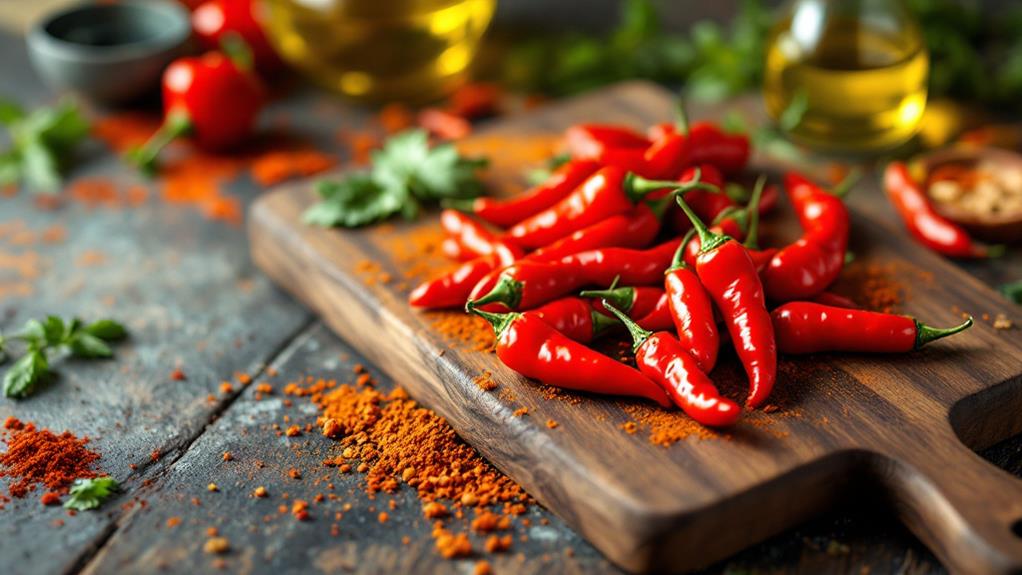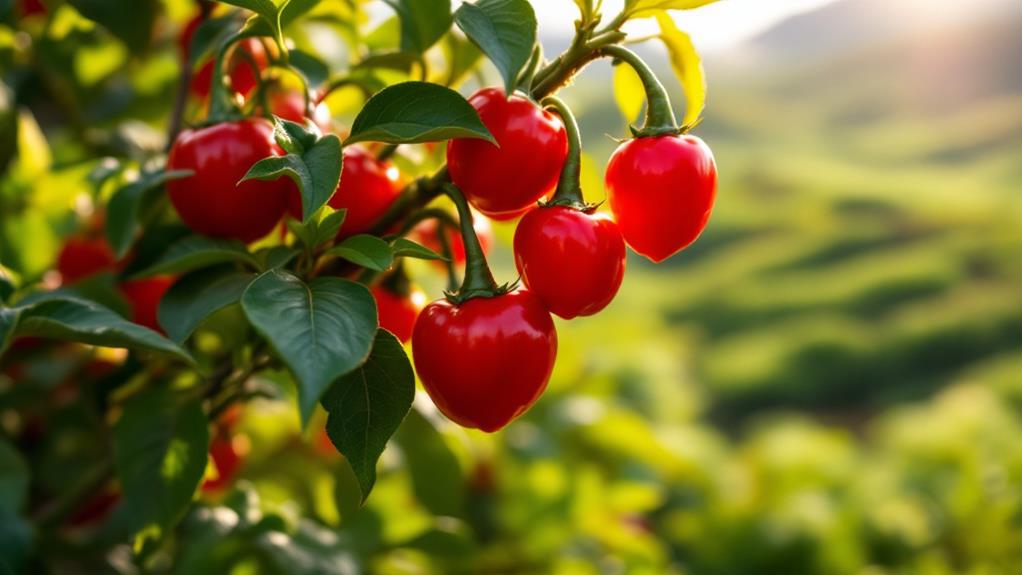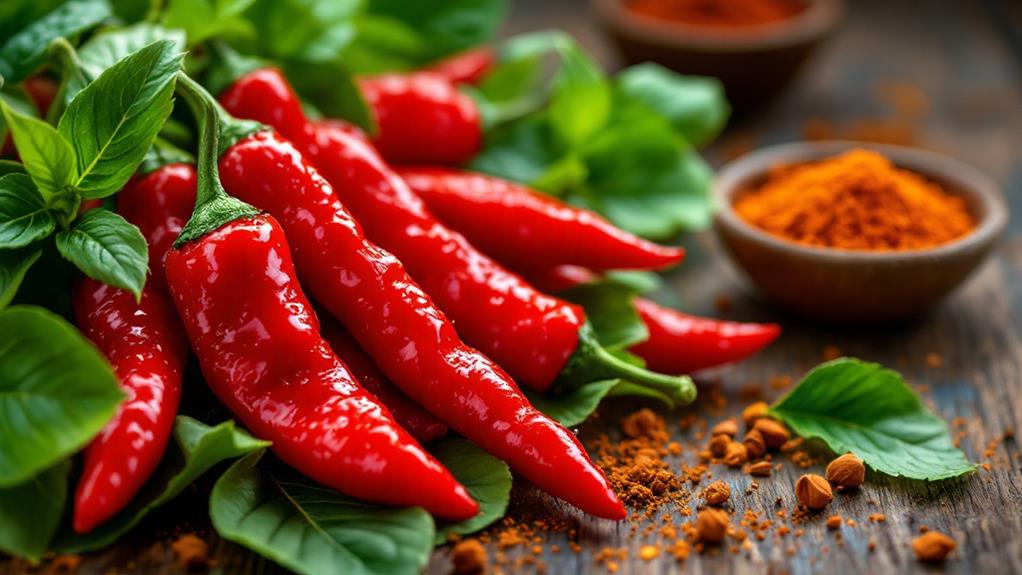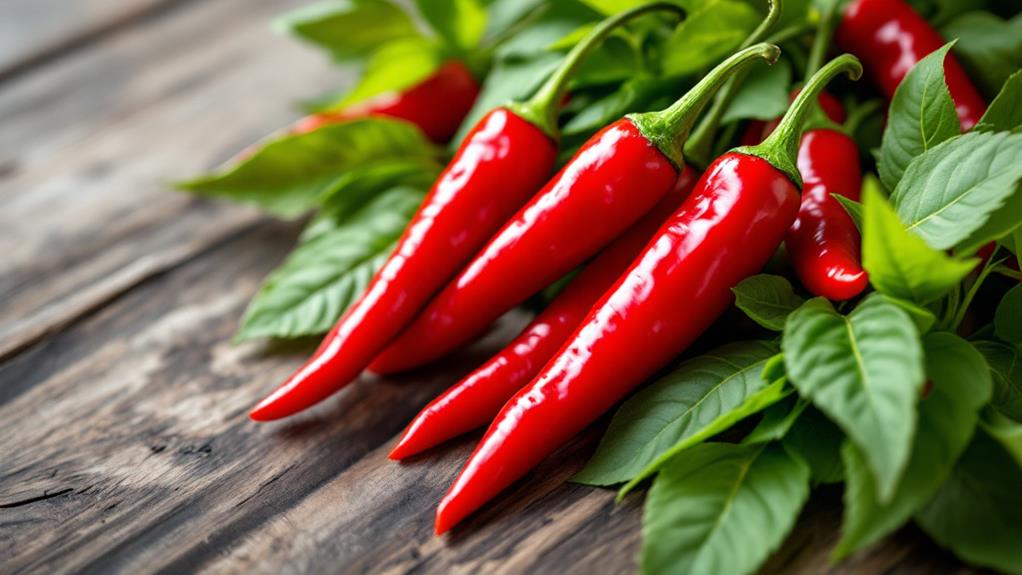The Hot Dragon’s Breath Pepper: Everything You Need to Know
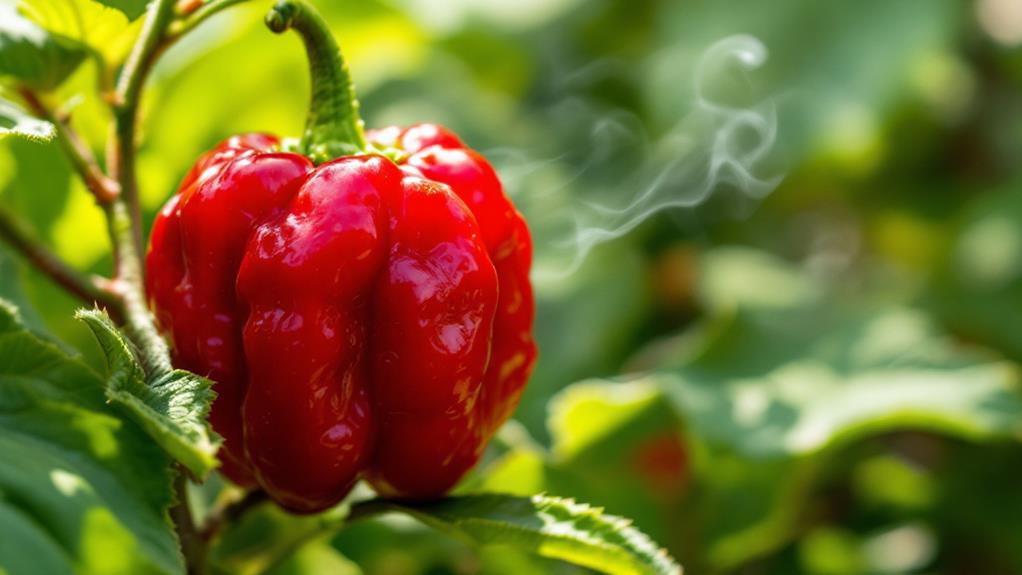
If you're curious about the Dragon's Breath pepper, it's a fiery marvel born in Wales by Mike Smith and Neil Price. With a heat level of 2.48 million Scoville Heat Units, this pepper surpasses even the Carolina Reaper. Its intense spiciness isn't for the faint-hearted and could pose health risks like severe allergic reactions. However, it also has intriguing medicinal potentials, such as pain relief. This pepper's floral and bitter notes add a kick to dishes while needing careful handling. There's much debate around its true heat claims and safety concerns, leaving room for further exploration.
Origin and Development
The Dragon's Breath pepper has an intriguing origin story that begins in Wales, United Kingdom, where it was developed by horticulturist Mike Smith with help from chili farmer Neil Price. Together, they set out on creating a pepper that would not only be fiery in its heat level but also serve a greater purpose in medical research, particularly for pain relief. This unique pepper is a hybrid, primarily combining the Naga pepper with other varieties, resulting in an exceptionally hot creation.
What makes the Dragon's Breath pepper stand out isn't just its potential medicinal applications but its staggering 2.48 million Scoville Heat Units (SHU), a heat level that challenges even the infamous Carolina Reaper. This powerful number places it among the world's hottest peppers, attracting attention from both chili enthusiasts and scientific communities.
Named after the iconic Welsh Dragon, the pepper doesn't just represent its origin in Wales; it embodies the fiery spirit of the region. It was intended for display at the 2017 Chelsea Flower Show, capturing attention with its impressive heat and compact pod size of about 1-2 inches. This pepper's floral and bitter flavor profile adds even more allure to its fascinating backstory.
Heat Level Insights
While the origin of the Dragon's Breath pepper is fascinating, its heat level is what truly captivates enthusiasts. Measuring an astounding 2.48 million Scoville Heat Units (SHU), this pepper doesn't just push boundaries; it shatters them. If you've ever tried the infamous Carolina Reaper, which averages around 1.6 million SHU, you'll find the Dragon's Breath takes spiciness to a whole new universe. Imagine the fiery intensity of pepper spray, typically ranging from 500,000 to 2 million SHU, and you're getting close to understanding the Dragon's Breath experience.
When you bite into a Dragon's Breath, you're not just tasting heat—you're feeling it. The capsaicin levels are so high that they cause a severe burning sensation, especially if you're not accustomed to such intense spiciness. Even though individual peppers may vary in heat, the average potency remains consistently high, making it a challenge for even the bravest spice lovers. Regardless of whether you're a thrill-seeker or a spice enthusiast, the Dragon's Breath promises an unforgettable, if not searing, experience. Just remember, this pepper is not for the faint-hearted or those unprepared for its burning wrath.
Health Risks and Safety
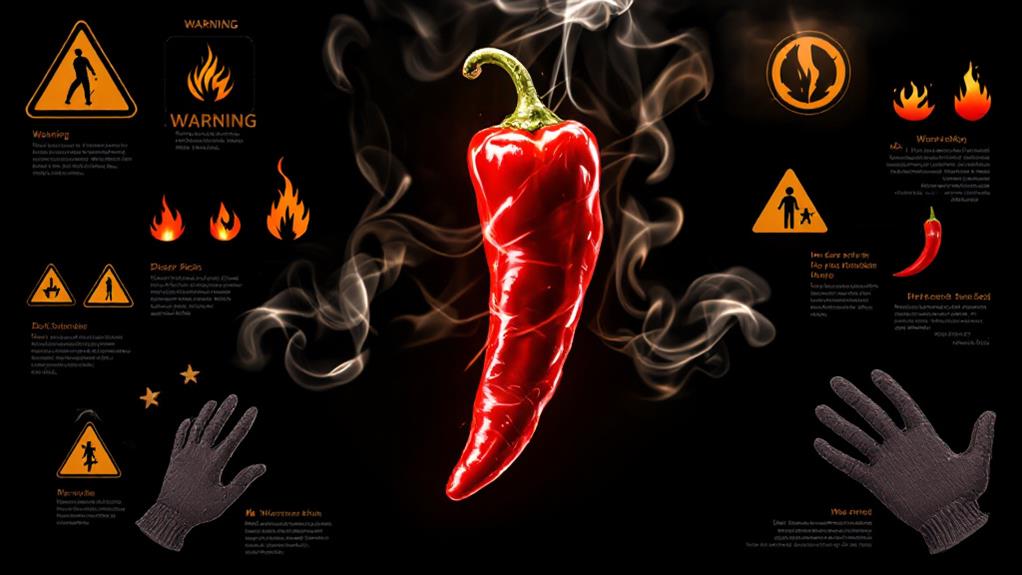
Bravery might tempt you to try the Dragon's Breath pepper, but caution should be your guiding principle. With a staggering 2.48 million Scoville Heat Units (SHU), this pepper isn't just hot—it's potentially dangerous. Its capsaicin content can cause severe health risks, including anaphylactic shock, especially if you're prone to allergies or have a low tolerance for heat. If you decide to handle or consume it, you must be aware of these risks.
The Dragon's Breath pepper's heat level is comparable to pepper spray, hovering around 2 million SHU, which highlights its potency. Consuming even a small amount can lead to serious reactions. Allergic reactions might cause your airways to close, making it difficult to breathe. It's essential to have antihistamines on hand if you know you're sensitive to peppers.
Though the minimum lethal dose of capsaicin is quite high—between 5.8 grams, or about 50-100 pods—it's important to keep in mind that even minor exposure could result in significant discomfort or health emergencies. Always approach the handling and cultivation of this pepper with care, as misuse could lead to unintended consequences. Safety should always come as a priority.
Medicinal Potential
Exploring the medicinal potential of the Dragon's Breath pepper, you'll find its capsaicin content at the forefront of research for alternative pain relief. Capsaicin, the compound responsible for the pepper's fiery heat, is being studied for its ability to numb the skin, offering therapeutic applications in pain management, especially for those allergic to traditional anesthetics. This makes the Dragon's Breath pepper an intriguing candidate for use in medical settings where alternatives are needed.
Additionally, there's promising evidence that capsaicin could aid in weight loss and metabolism improvement. While initial studies suggest these benefits, further research is necessary to conclusively determine its effectiveness in these areas. The intense heat of the Dragon's Breath pepper, however, necessitates careful handling to avoid severe reactions, including anaphylactic shock, particularly in sensitive individuals.
The pepper was originally developed with a focus on medical research, highlighting its potential as a cost-effective pain relief solution, especially in developing countries. Its medicinal potential is not only limited to pain relief but extends to multiple therapeutic applications, offering a glimpse into creative, natural solutions for managing pain and possibly aiding in metabolism-related health improvements.
Culinary Uses
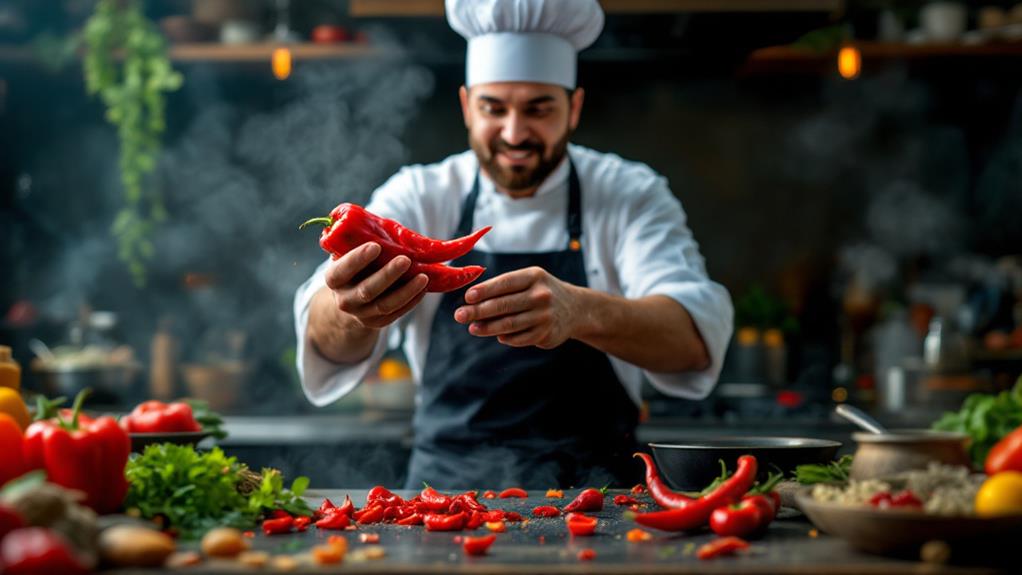
Some might argue that the Dragon's Breath pepper is not for the faint-hearted. With its extreme heat reaching 2.48 million SHU, it's no surprise that these peppers find their way into the culinary applications of those seeking intense spice. Regardless of whether you're a chili enthusiast or a gourmet chef, this pepper can contribute a fiery kick to your creations. However, due to its intense heat, you'll want to use it sparingly in your recipes. Even a tiny amount can dramatically enhance the spiciness of your gourmet dishes.
Dragon's Breath peppers boast a unique flavor profile, described as both floral and bitter. This makes them perfect for improving the complexity of spicy marinades, dressings, and gourmet dishes when used in moderation. You can dry and grind them into flakes or powder, making them a versatile supplement to spice blends. This allows you to easily incorporate their extreme heat and potent flavor into a variety of culinary creations.
Thanks to their rapid growth cycle, Dragon's Breath peppers can be harvested in about 90 days. This means you can timely include them into seasonal dishes or even events centered around spicy food challenges.
Public Perception
Public fascination with the Dragon's Breath pepper is undeniable, largely fueled by its staggering 2.48 million SHU, which potentially crowns it as the world's hottest pepper. The public interest in these peppers skyrocketed, driven by the pepper's association with extreme heat and the anticipation of Guinness World Records certification. The Chelsea Flower Show and numerous media outlets spotlighted the pepper, often likening its fiery intensity to pepper spray, which measures around 2 million SHU. This comparison not only intrigues but also cautions the public, as it highlights the pepper's formidable heat.
Safety concerns surrounding Dragon's Breath peppers contribute greatly to their perception. With the potential to cause severe burns or even anaphylactic reactions, many question the wisdom of consuming them. These dangers spark debates about their place in culinary contexts, urging caution among adventurous eaters.
Moreover, skepticism permeates the chili community. Doubts about the authenticity of the pepper's heat claims persist, prompting calls for scientific verification and replicated field trials. Until these claims are substantiated, skepticism remains a key component of public perception, tempering the world's immense curiosity and interest.
Historical Comparisons
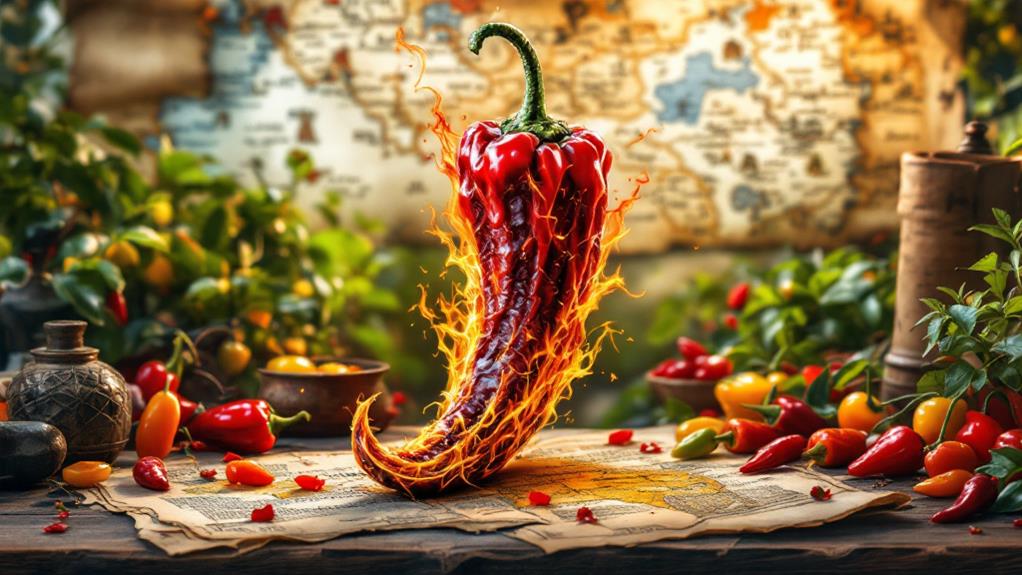
The evolution of chili peppers, marked by ambitious breeding efforts, has led to the Dragon's Breath pepper eclipsing its fiery predecessors. Historical records reveal a fiery timeline where the pursuit of intense heat has been relentless. You might recall the Carolina Reaper, the world's hottest pepper from 2013, with a scorching 1,569,300 Scoville Heat Units (SHU). Fast forward to 2017, and the Dragon's Breath pepper shatters this record with an astonishing 2.48 million SHU, setting a new benchmark.
The expedition didn't start there, though. The Ghost Pepper, once the hottest at 1,041,427 SHU, paved the way for modern contenders. Breeding efforts have evolved from traditional methods to scientific collaborations, aiming to optimize capsaicin concentrations. This shift is evident in the Dragon's Breath pepper's development, initially intended for medicinal use rather than culinary endeavors.
It's fascinating to contemplate how these peppers have transformed from kitchen staples to "weapons-grade" heat bringers. As you explore these fiery feats, you can't help but wonder about the implications of breeding peppers with such lethal heat levels. The Dragon's Breath pepper, with its unprecedented heat, challenges the boundaries of what peppers can become.
Growing Tips
When cultivating Dragon's Breath peppers, you'll often find that achieving their full fiery potential requires attention to specific growing conditions. These peppers thrive best in well-draining soil and need full sun exposure. It's vital to start seeds indoors at least six weeks before the last frost. This gives the peppers a head start, allowing them to grow strong enough to face the elements once transplanted outside.
Once your seedlings reach about 8 inches tall, and the outdoor temperature is consistently between 70-90°F (20-32°C), they're ready for transplanting. At this stage, incorporate bone meal into the soil. This supplement raises calcium levels and improves the complete nutrient content, promoting healthier plant development. Careful monitoring of moisture levels is significant, as it guarantees the plants are neither too dry nor too waterlogged, which could affect their growth.
Keep these growing tips in mind:
- Full Sun Exposure: Verify your plants get plenty of sunlight.
- Well-Draining Soil: Prevent root rot by using soil that drains well.
- Bone Meal Supplement: Improve nutrients for stronger plants.
Fruits typically develop about 90 days post-transplant, so patience and care are key.
Controversies and Concerns
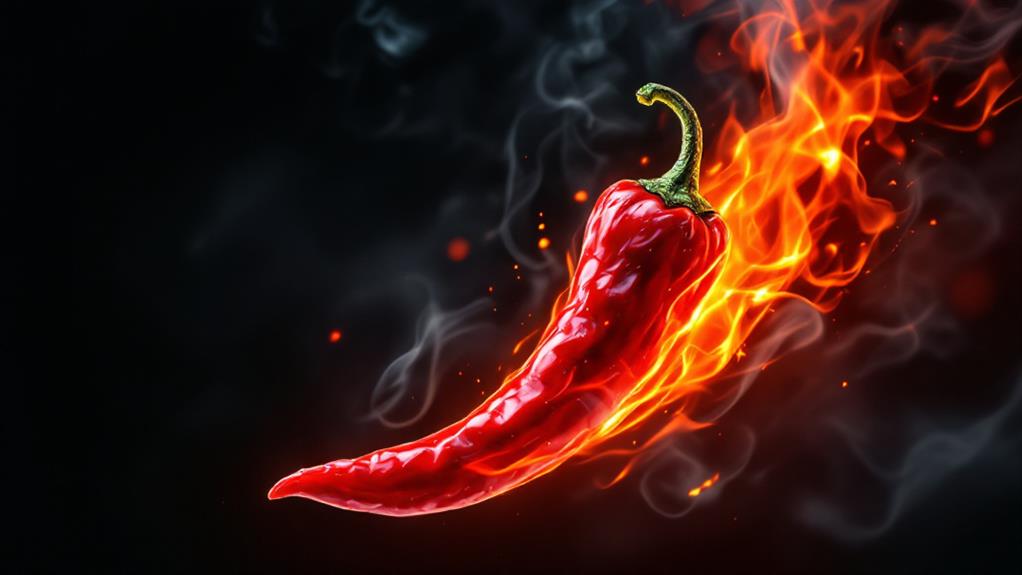
As you nurture your Dragon's Breath peppers to reach their fiery potential, it's vital to be aware of the controversies and concerns that surround this potent pepper. The claimed heat level of 2.48 million Scoville Heat Units (SHU) sparks skepticism among chili enthusiasts. Many question the authenticity and genetic stability of the Dragon's Breath pepper seeds, wondering if they truly live up to their reputation.
The extreme capsaicin content in these peppers raises significant safety concerns. Individuals with known food allergies must exercise caution, as the risk of anaphylactic shock is a serious issue. This is especially significant if you're considering participating in culinary challenges or pranks involving these peppers, given their heat level is comparable to pepper spray.
Regulatory scrutiny also looms over the cultivation and sale of Dragon's Breath seeds and pods. Proper handling and awareness of potential risks are vital. Within the pepper community, there's an ongoing call for replicated scientific trials to verify heat claims and guarantee accurate reporting of the pepper's characteristics. By staying informed, you can better navigate the fiery world of Dragon's Breath peppers safely and responsibly.

